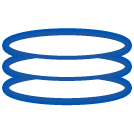Fiche publication
Date publication
mars 2025
Journal
Journal of nuclear medicine : official publication, Society of Nuclear Medicine
Auteurs
Membres identifiés du Cancéropôle Est :
Pr MARIE Pierre-Yves
Tous les auteurs :
Zaragori T, Chevalier E, Citerne Q, Roch V, Hossu G, Marie PY, Boursier C, Imbert L
Lien Pubmed
Résumé
Absorbed doses (ADs) may be calculated through serial conventional SPECT imaging after therapeutic [Lu]Lu-DOTATATE injection but with recording times too long for clinical routine. The aim of this study was to determine whether activity concentrations and ADs calculated from a high-speed whole-body 360° cadmium-zinc-telluride (CZT) SPECT camera are comparable to those provided by conventional SPECT. Fifteen patients referred for [Lu]Lu-DOTATATE treatment were enrolled and underwent, at 24, 96, and 168 h after [Lu]Lu-DOTATATE injection, 32 min of thoracoabdominopelvic conventional SPECT recording and 18 min of whole-body CZT SPECT recording. The order of device procedure (conventional or CZT SPECT) was randomly selected to avoid bias. The kidneys, bone marrow, liver, and spleen were automatically segmented by an artificial intelligence-based tool on CT images, whereas the largest tumor was segmented manually on CT or MR images. Time-integrated activity curves were computed using activity concentrations from the kidneys, bone marrow, liver, spleen, and tumor and convolved by the voxel S-value kernel to calculate AD values. The partial-volume effect was corrected by fitting the recovery coefficients of 1- to 113-mL spheres. Activity concentrations (in Bq/mL) and ADs (in Gy/GBq) were expressed as median (minimum to maximum) and compared between the 2 cameras with Wilcoxon tests. Activity concentrations and ADs were not significantly different between conventional and CZT SPECT, respectively, for the kidneys (337.3 [203.3-622.4] vs. 342.7 [218.2-547.8] kBq/mL at 24 h and 0.45 [0.26-0.79] vs. 0.47 [0.25-0.79] Gy/GBq), spleen (340.3 [171.8-703.1] vs. 277.7 [215.6-640.8] kBq/mL at 24 h and 0.48 [0.31-1.41] vs. 0.50 [0.35-1.15] Gy/GBq), bone marrow (32.7 [13.9-662.9] vs. 41.1 [12.4-509.6] kBq/mL at 24 h and 0.09 [0.04-1.96] vs. 0.13 [0.06-0.87] Gy/GBq), and largest tumor (826.8 [376.4-4,459.0] vs. 1,116.7 [447.0-6,043.3] kBq/mL at 24 h and 1.8 [0.9-5.7] vs. 2.0 [1.0-7.3] Gy/GBq). However, significant, albeit small, differences were observed for the liver (126.2 [42.7-335.9] vs. 113.5 [35.1-293.4] kBq/mL at 24 h and 0.23 [0.07-0.72] vs. 0.21 [0.05-0.64] Gy/GBq, both < 0.01). Activity concentrations and absorbed doses calculated from the 360° CZT SPECT/CT system after [Lu]Lu-DOTATATE injection are globally comparable to those obtained from a conventional SPECT/CT system. However, CZT SPECT/CT is more appropriate for clinical routine, with shorter recording times and actual whole-body coverage.
Mots clés
CZT camera, SPECT/CT, [177Lu]Lu-DOTATATE, dosimetry, quantification
Référence
J Nucl Med. 2025 03 20;:






